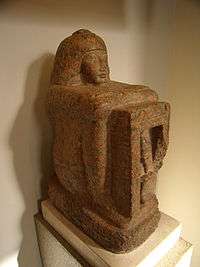Ankhkherednefer
Ankhkherednefer (Ancient Egyptian: ˁnḫ ẖrd nfr, lit. ''The beautiful child lives there'')[1] (name formerly read as Ankhrenepnefer, or Ankhsherynefer) was an ancient Egyptian official known from a block statue found in the Tell el-Maskhuta (perhaps ancient Pithom). The statue, made of red granite is now in the British Museum (BM 1007).
| Ankhkherednefer's official titles in hieroglyphs | |||||||||||
|---|---|---|---|---|---|---|---|---|---|---|---|
Rwḏw-ˁ3-n-ˁḥ Great Inspector of the Palace | |||||||||||
Sḫ3-nfr-n-pr-Tm-nb-ˁjn Good scribe of the Temple of Atum, Lord of Tura[note 1] | |||||||||||
Ḥrj-jdnw-n-pr-ˁ3 Supreme Lieutenant of the Pharaoh | |||||||||||
 | |||||||||||
Biography
| Ankhkherednefer in hieroglyphs |
|---|
Ankhkherednefer served under king Osorkon II whose name appears on the statue. On the statue he bears the titles: Great Inspector of the Palace; Good scribe of the Temple of Atum, Lord of Tura[note 1] and Supreme Lieutenant of the Pharaoh.
gollark: You could use GPT-Neo, though.
gollark: GPT-3 is not public.
gollark: I can give you more information on our defensive systems for estimates, although I may have to erase your memory afterward.
gollark: Oh, those are nullified by the muon apiocity amplification arrays ever since what happened in 1998.
gollark: 98.853%? Our backup systems are very robust, thank you.
References
- Notes
- Citations
- Hermann Ranke (1935). Die Ägyptischen Personennamen - Band I (PDF) (in German). Augustin, Glückstadt. p. 66.
- Kathryn A. Bard (1999). Encyclopaedia of the Archeology of ancient Egypt. Routledge, London. p. 958. ISBN 0-415-18589-0.
Literature
- Edouard Naville: The Store-city of Pithom and the Route of the Exodus, London, 1885, S. 13-14 with English translations of the texts, Frontispice, Text on plate IV). online
- Karl Jansen-Winkeln: Ägyptische Biographien der 22. und 23. Dynasstie, Teil 1, Wiesbaden 1985, S. 269-71 ISBN 3-447-02525-5
- Karl Jansen-Winkeln: Inschriften der Spätzeit, Bd. II: Die 22.-24. Dynastie, Wiesbaden, 2007, S. 126-127
External links
| Wikimedia Commons has media related to Ankhkherednefer. |
This article is issued from Wikipedia. The text is licensed under Creative Commons - Attribution - Sharealike. Additional terms may apply for the media files.